Jörg Burzer, the carmaker’s manufacturing chief, explains how it has reorganised its production network for electric vehicles and powertrains, while speeding up the rollout of digital tools. Now, another phase of change is just ahead.
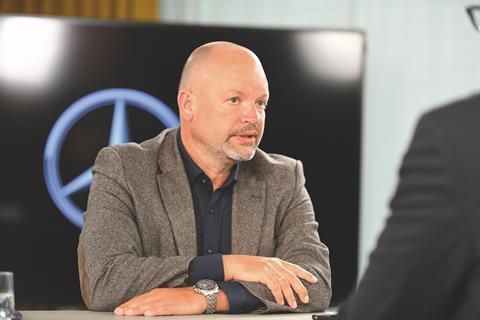
Pascal Nagel: Mr Burzer, it’s been around a year since our last conversation. What has happened in the Mercedes-Benz production network since then?
Jörg Burzer: Quite a lot! In the summer of 2022, which must have been shortly after our interview, we announced a new production alignment for our next generation of electric vehicles. Later in the year, we also announced orders for our powertrain production network. As an organisation, we are quite proud of the result. The decisions created clarity for our locations and the full focus is now on implementation.
We have also set the course for sustainability at our sites, for example expanding wind farms and photovoltaic plants.
Last but not least, we have made progress in digitalising our plants by securing key partners including Microsoft, Nvidia and Siemens.
These achievements have given us an enormous boost in transforming our plants towards electromobility. As you can see, we have not been bored [laughs].
Then let’s look ahead: The reorganisation of your production network is a big step. What do you expect from the new setup?
We’ve already had several EV launches, such as the Mercedes-Benz EQE in Bremen [Germany], the EQS in Sindelfingen [Germany] and the EQS SUV in Tuscaloosa, Alabama [US], which we have fully integrated at existing locations. Now, by defining locations for the electric programmes from 2024 onward, we have kicked off the second stage of our transformation.
In the future we will be producing vehicles on the MMA [Mercedes Modular Architecture] platform, which will be our ‘entry luxury’ models, as we call them, in Rastatt [Germany], Kecskemét [Hungary] and Beijing [China].
In Bremen, Kecskemét and Beijing, meanwhile, we will produce EVs based on our MB.EA [Mercedes-Benz Electric Architecture], while in Sindelfingen our future top-end models will be based on the AMG.EA [AMG Electric Architecture]. It was also important to us that we continue to manufacture the new EV models on three continents: here in Europe, in China and in the US. With this realignment, we are well positioned for launches over the coming years.
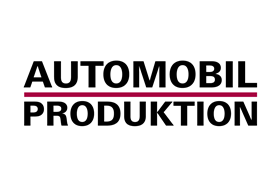
This article first appeared in German in Automobil Produktion, an AMS sister publication. Den Artikel auf Deutsch lesen
Do you anticipate further adjustments in the production network?
As I have already indicated, we are now in the second stage of the transformation towards electromobility. In the third stage, we will plan launches for the end of the decade and the beginning of the 2030s. By then, our network will certainly develop further. The most important thing is that we have a clear plan and are focused on implementing our decisions.
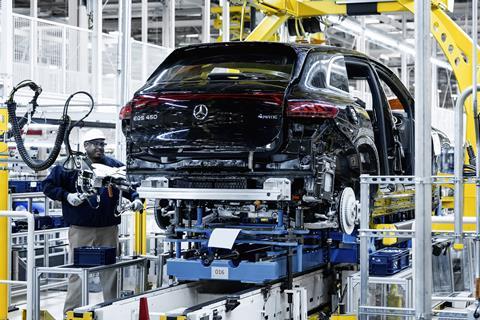
Clearly, a lot has changed at Mercedes-Benz in the past year. What hasn’t changed much, on the other hand,is the need to operate in a near perpetual crisis mode.How have you developed the resilience of your worldwide production networks?
We have mainly worked on our tools, the most important being digitalisation. On the one hand, digital tools help us to achieve transparency in the supply chain. On the other hand, they help us to make decisions, for example about how to steer our production network. But something else is much more important.
And what is that?
We have established a new decision-making culture. As an organisation, we make important decisions much faster than before. This is one of the most central consequence of the crisis for me: we have changed our culture.
Other resiliency strategies have included the localisation of suppliers. A recent example at Mercedes-Benz has been your partnership with Rock Tech in sourcing lithium hydroxide. Is that setting a precedent for other materials?
Our colleagues in procurement are working intensively on these questions. But of course, raw materials sourcing plays an important role for us as an OEM. In leading production, the more relevant task for me is how technology can help us to use materials differently, for example in recycling. We have just laid the foundation stone for a battery recycling plant.
That would have been my next question.What is your roadmap interms of recycling and circular use of materials?
The initial focus over the next few years will be working out the processes. However, the new factory won’t be an experimental laboratory, but a real pilot factory that will help us to really map and use these processes. Within the next two or three years, I expect to fully develop these processes and then we can really scale circularity and recycled materials in the second half of the decade. There are a wide variety of ways we can use this material, with the most obvious as energy storage, for example in the electricity at our facilities generated by photovoltaic systems. Another stage will be remanufacturing and ultimately recycling.
You have mentioned digitalisation several times. The MO360 platform marks the next stage for Mercedes-Benz on the way to the smart factory. What is your progress in achieving this goal?
That’s the beauty of innovative developments: you never know what the end result will look like, let alone exactly where you are. I think it is more than obvious that all industries are finally stepping into the age of digitalisation.
For us, Factory 56 points towards the future of manufacturing, many aspects of which are already a reality in other plants. But what is implementable today and what is mood music for the future music changes extremely quickly in terms of technical development. That makes it difficult to give an update on the status quo.
However, let me put it this way: I am very pleased with how far we have come since the introduction of MO360. Together with our partners, we are working on different facets of production digitalisation. We have partnered with Siemens on the interfaces between our plants and the cloud.
The company is also a strong partner in our Digital Factory Campus in Berlin. Microsoft helps us, meanwhile, to digitalise our processes on the shopfloor. And with Nvidia, we are creating virtual environments of our production planning processes via digital twins.
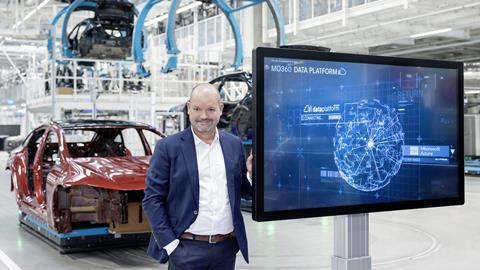
Does MO360 also help you with transparency along the entire supply chain?
The question is what we mean when we talk about the entire supply chain? Do we go to the Tier-6 or Tier-7 suppliers? Or all the way to the raw material suppliers? Together with Tier-1 suppliers, OEMs have learned a lot in the past two years about supply chain transparency. The challenge now will be to take that to the appropriate tier levels. That is a big challenge, but initiatives like Catena-X are absolutely going in the right direction. In the end, I am convinced that greater transparency will help the entire industry.
The meta- or omniverse is currently a big hype in digitalisation. How do you rate the technology?
This is one of the most fascinating developments in recent years. It puts us in a position to work with unprecedented data quality and plan factories virtually. It would also save us expensive change management processes, which really cost a lot of money.
What role do the individual production locations play as drivers of digital tools?
The most decisive one! In the central production department, we only advance tools and make them available across plants, while the real ideas and innovations come from the factories themselves. What is important is how quickly we can update these tools.
Currently, we rollout relevant production changes fortnightly. This means that an innovation that comes from a worker or team leader on the production line is available in central applications two weeks later. That brings me back to having a culture of quick decision-making. If the teams on the shopfloor see that ideas are actually being implemented, and quickly, then of course it’s much easier to motivate employees to get involved.
Indeed, these innovations must come from those who work with them every day in the factories. You can’t come from outside and impose a solution that doesn’t reflect the reality of work in the plant.
Is there a risk that this rapid integration could overwhelm teams on the shopfloor?
That is why the usability of digital tools – the user experience – is so important. That is our top priority. From monitoring usage data we can detect very quickly if we have perhaps taken a wrong turn in an update and are losing people, and we can quickly take countermeasures. The democratisation of data is also crucial. There have certainly been cases in the past where information was only partially available to staff. We have been working on improving this, especially in the past twelve months.
On the other hand, we are investing in a variety of qualification measures. At our Digital Factory Campus in Berlin and our powertrain plant in Untertürkheim [Germany], for example, we train shopfloor employees to become programmers. We also develop and test a variety of software tools there. Once the tools are proven effective, we roll them out to the plants.
From which production area do most digital innovations originate?
When we began to digitalise shopfloor processes, we clearly saw the most innovations in assembly. Many also came from powertrain production. Now, we are seeing more innovations from the body shop, especially in using artificial intelligence for prevention and error avoidance. A lot is happening in this area.
Finally, if we were to meet again in a year’s time, what do you hope to be able to update us on?
Perhaps next year we can talk in more detail about the third stage of our transformation. The topic of digitalisation will also be even more important and create new opportunities. By then, hopefully we can stand together on the roof of the eCampus in Untertürkheim, where I would like to show you just how big such a photovoltaic system can be. But the roof is still empty [laughs] - the campus is still under construction.
Jörg Burzer, Mercedes-Benz: a career in production transformation
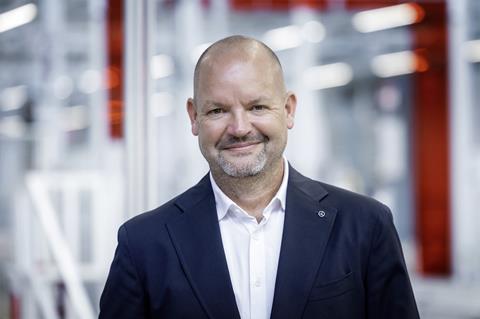
1999 Project Manager Predevelopment Passenger Cars at Daimler-Chrysler
2002 Manager, Purchasing Powertrain/Material Management
2004 Senior Manager, Global Powertrain
2007 Director, Interior Purchasing E- and C-Class
2010 Director, Head of Production Control and Logistics, Tuscaloosa (USA)
2013 Director, Product and Production Strategy & Supplier Quality, Beijing
2016 Director, Vice President, Head of Quality Management Mercedes-Benz Cars 2019 Executive Vice President, Member of the Board of Management of Mercedes-Benz responsible for the Production & Supply Chain Management division
2021 Member of the Board of Management of Mercedes-Benz Group; Production and Supply Chain Management
Topics
- Artificial intelligence
- Asia
- Assembly
- Automation and Digitalisation
- Bodyshop
- Connected Manufacturing
- Electrification
- Europe
- EV manufacturing
- Expansion
- Factory Investment
- Factory Transformation
- Industry 4 and Smart Factory
- Logistics
- Mercedes-Benz
- North America
- OEMs
- Operational Excellence
- Plant Functions
- Powertrain
- Recycling
- Smart Factory
- Sustainable production
- Systems






























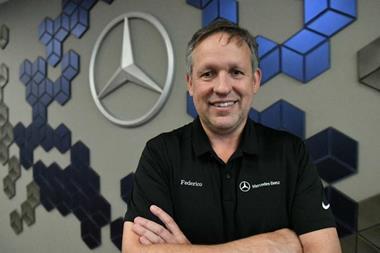
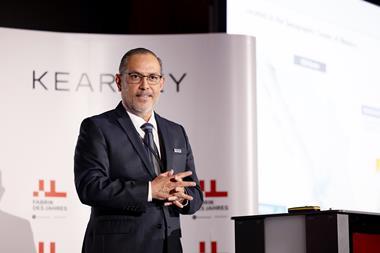
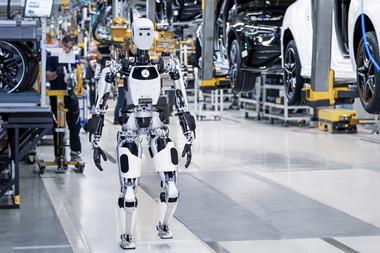
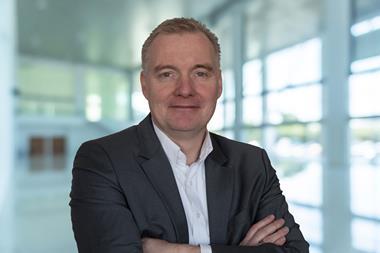
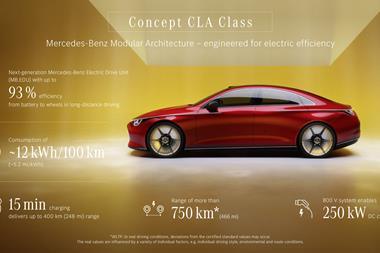



No comments yet